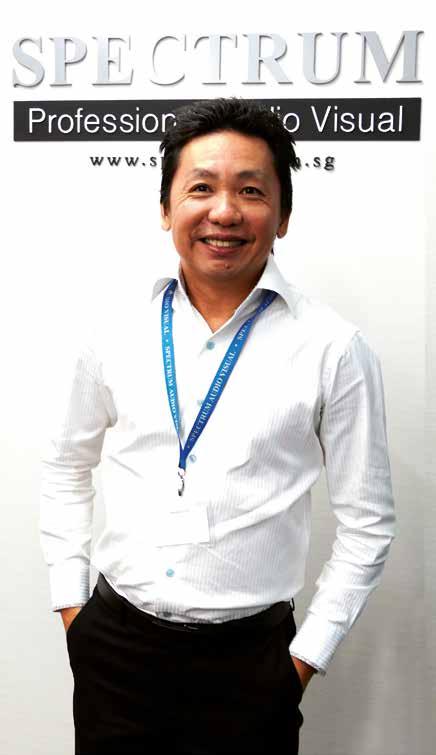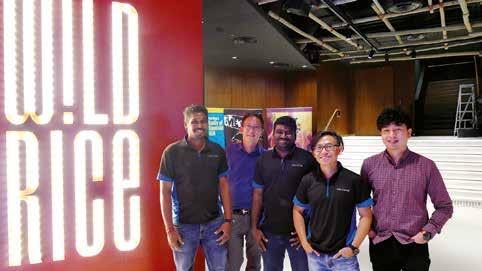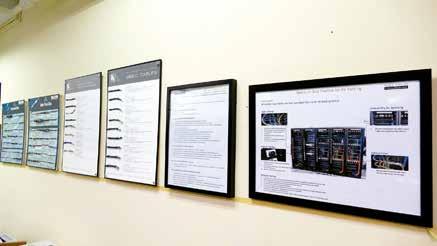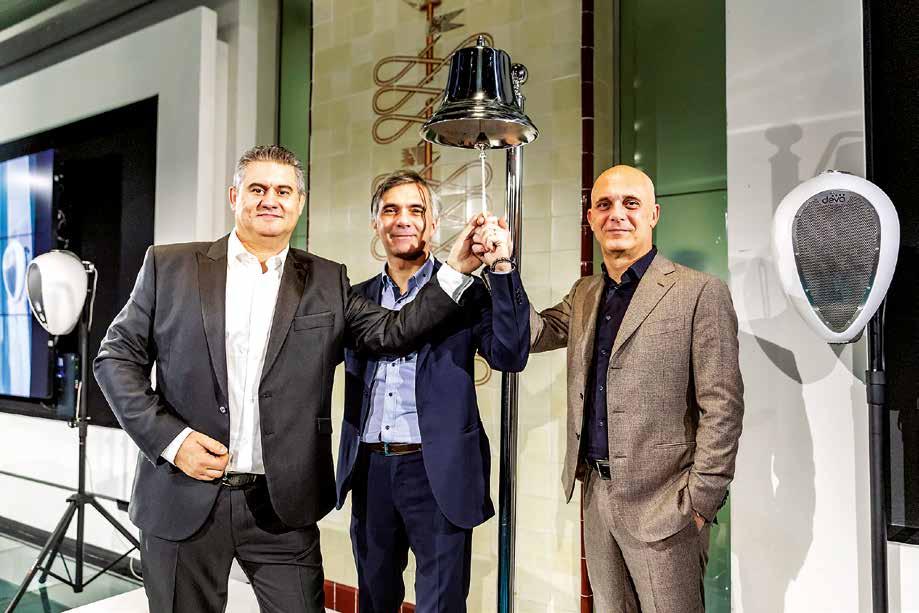
18 minute read
Company Profile
Pro AVL Asia takes a glimpse into the world of Vincent Chua, head of one of Singapore’s slickest AV integration businesses, Spectrum Audio Visual
Like most self starters in life, Vincent Chua has an energy surrounding him that is infectious to anyone he comes into contact with. ‘I’ve dreamed about being an entrepreneur since I was young,’ he freely admits. Starting the business from scratch in 1999 has demanded high energy levels and gritted determination. With a workforce of 85 and counting, Spectrum AV has succeeded where so many have stagnated, or worse, in one of the world’s most competitive AV markets.
Advertisement

Spectrum AV managing director and founder, Vincent Chua
‘First, you must start with a dream,’ he says. ‘Then you dream bigger; don’t limit yourself and target where you are going. If you’re not comfortable with what it is right now, that will motivate and remind you that you have to grow. So, I set my mind on where I wanted to grow with whatever came under AV. That’s why we’re called Spectrum – it’s a full spectrum of colour.’
From the outset, Chua admits that certain people have played a significant role in starting the business. ‘I was very fortunate to kick-start my business with two good friends who helped me take care of the operations and the delivery of all our projects. We started with a small office on Beach Road with three staff and our warehouse was a small corner of that office. I didn’t even have the money to buy the door, so we used a handmade curtain to cover up all the incoming goods.’
Chua acknowledges that leadership and teamwork have both been vital ingredients in the growth of Spectrum AV over two decades. ‘For the first 10 years it was tough, but I was very lucky to have Dickson Ang, Wendy Yeo and Eddie Seng running the business. Over the next decade, Eddie Seng was assisted by Eddie Chua, Wayne Soo and Selena Lai.
The people make it happen and, during the last few years of growth, I have had minimal involvement. We continue to source new talent all the time, but it’s always difficult to recruit as there is a limited pool. It’s important to bring in the right talent for the right positions, but then training takes precedent.’
Like Spectrum AV’s solid foundations, the company structure has strengthened and evolved over those two decades to take its current shape. The 45 certified and qualified engineers and technicians within the engineering division are divided into their specialised areas, including audio, automation and video. All the equipment racks are built meticulously offsite at company headquarters in Ubi, before being carefully loaded and transported to site in a manner akin to precious cargo.
On the day of Pro AVL Asia’s visit, this nerve centre of engineering was completing a large project phase for Microsoft in which Extron and Q-Sys components were being programmed, in addition to several other ongoing jobs. ‘I strongly believe in quality and consistency of delivery. To achieve that, we establish best practices in each team, each process and each stage of implementation.
That means power cords must have the proper labels such as a black colour label on black surfaces and a white colour label on white surfaces. It takes time to instil discipline in maintaining the standards of quality consistently, so that’s why I always check and talk to the engineers so that they understand what we’re doing. In doing so, we add value.’

Spectrum AV’s office and HQ
As a result, the outgoing racks possess a Spectrum AV signature that reminds the client that they have bought into quality and peace of mind once they have been connected and terminated onsite. Nevertheless, Chua believes that there is still a lot to improve on.
‘I don’t think we are the best and we still have a lot more to do,’ he admits. ‘The quality of the delivery in terms of the solutions, in addition to the customer experience, remains vital. How do we want to deliver our products, including the small things such as running cables, terminations, visible racking and commissioning? We need to continuously enforce best practices and ensure that each stage of the project is executed correctly offsite before delivering to site.
As we constantly try to raise the bar, we know that we are pressuring ourselves, but we are hopefully turning that to our advantage.’ Following commissioning, the customer service centre takes over, providing 24/7 support comprising a technical hotline, fault ticketing system, ad-hoc engineering and maintenance.
‘Throughout the implementation of a project, the designer is the only one who can make changes in any design. If the departments have a problem, they will need to communicate with one another and have meetings amongst themselves. There’s a cycle starting with Eddie Seng leading the AV design team, where the project effectively begins, to Eddie Chua leading the project delivery department and ending with Eddie Seng leading the post-sales team following completion.’
Distinguishing itself from other systems integrators in the region, Spectrum AV has not got into product distribution. This refreshing integral approach allows the company to create a neutral design template based on the best-possible solution available for the client’s bespoke requirements rather than a limited range of assembled products from a distribution portfolio.
‘If a project calls for a column speaker solution, you know there are many brands around. Most SIs will promote the one they distribute and that limits you. For example, some passive columns have no tweeters, some have two tweeters, others eight tweeters. Vocal ranges and musicality vary according to the low-frequency and high-frequency components. So, it depends on the customer’s specific application and, by not limiting your choices, you can choose the best selection for your customer. Our clients have a vision and our experts can deliver that.’

The Spectrum AV team recently completed the audio install at the newly opened Wild Rice Theatre
The SI is also equally at home in corporate, house of worship, hospitality and broadcast environments. ‘The delivery teams here have expertise in diverse fields. They may be specialised within a particular field of audio, but they can apply their expertise at a more entry level. We make sure that each group is a specialist in different vertical markets, while maintaining a fundamental basic skill set of all other AV aspects, including video projection and programming.
‘To stay current, however, ongoing training and certification is just as important as recruiting the right expertise from various sectors. For example, some of the engineers may be well versed in audio, but from a more corporate install background, so we need to train them to apply their skills in other sectors like hotels, auditoriums, theatres and houses of worship. That’s not easy because all aspects of training are mandatory, as all the new staff bring different skill sets. Therefore, we take them onsite and ensure that they understand the design and installation perspective for applications they are less familiar with.’
The transition from conventional AV to network AV is a work in progress. ‘It has been ongoing for at least 10 years, but it has really gained momentum during the last five years and continues to do so. You need to recognise this development and prepare for it. We equip our technicians with professional training, both locally and overseas, to be proficient in the work we do, before exposing them to the real thing. Some of the engineers have to change their mindset from AV to IT.
IT is nothing new to us as we have been specialised in video conferencing for many years – how to connect to the internet or intranet, set up a satellite link to a video call and so on. Some projects require specialised and customised programming – this can be very challenging to implement, as we have no reference from the manufacturers’ database.’ Warming to the theme, Chua stresses the importance of AV/IT integration.

A reminder of Spectrum AV’s best practices for AV racking
‘Programming is the key to automating equipment and it’s how we require the equipment to perform and communicate. As such, it’s the most complex and important part of AV integration. For example, our recent audio enhancement project at Universal Studio Singapore’s WaterWorld attraction springs to mind. The upgrade for the main audio system needed to be integrated with the main show control system so the production can synchronise all mechanical and pyrotechnic effects with audio cues.’
Having learnt some harsh lessons along the 20-year course, Chua has had to restructure the business on a number of occasions. However, his insight into the changing technology and business sectors is astute, if not visionary. ‘The corporate sector in Singapore continues to grow and, with it, so does the demand for AV technology. New corporate offices and executive showrooms rely on our expertise to enable their business structures. It’s gone beyond presentations in small rooms to collaborative meetings in larger applications. Our AV business will continue to grow as I believe that the budgets from corporations, hotels and the private sector will increase. And, with an ageing population, more private hospitals are being built with AV solutions.’
The conclusion of Pro AVL Asia’s interview takes us full circle, back to the dream analogy. ‘Once you realise a dream, you have to dream your next dream,’ says Chua. ‘Nobody can get to the top of the mountain – if you do reach the summit, you will soon discover that there’s a bigger mountain to climb. It’s endless. You learn and take your experiences to different customers across different sectors, from corporate to entertainment and many others.
For now, we have an office in Malaysia and are expanding our reach into ASEAN countries. You have to continue dreaming, and that means continually adapting your business and learning.’
The band plays on

In the beginning: Luca Lastrucci, Claudio Lastrucci and Antonio Peruch
Powersoft's colonisation of the professional power amplifier arena would take time to explain to an industry outsider. Dominated by a host of C-initialled manufacturers, the amplification landscape of 1995 was inhabited by heavy toroidal transformers offering industrial strength weights and designs with a varied track record of reliability. Today, the brand may be synonymous with power amplifiers and modules, but this is no indication of where its onward mission will take it.
It was all very different during those formative years at PLASA and Prolight + Sound Frankfurt. Together with his companion, Luciano Ciappi, Powersoft founder and president Carlo Lastrucci would receive bemused looks while promoting the company’s sleek Digam models. Channelling the energy levels of his products, Lastrucci remained unfazed, committing himself to taking the brand to unimaginable peaks – without clipping.

Twenty-five years later and still going strong
The cornerstone of Powersoft’s success has always been based upon full ownership, which has allowed the company to pursue a passion for engineering. However, when brothers Luca and Claudio Lastrucci graduated from their electronics engineering degrees, Luca, the elder by two years, was absorbed in software and the possibilities of artificial intelligence, while electronics engineer Claudio was fascinated by power management and hardware. Although the brothers shared a passion for music, playing drums, piano and guitar together in pubs and bars, there was little to bind them together in terms of business.
Having decided to start a company with Claudio’s long-term friend, Antonio Peruch, the trio looked at their wide-ranging skills and interests, and elected to try a little of everything. ‘It was supposed to be an engineering company,’ recalls Claudio. ‘It was the three of us collecting projects from various customers and doing the designs for many strange things. Not only audio devices, but automatic voice recognition systems, software, power conversion technologies and supply systems, conducting the installation of software and so on. Then we stopped and thought about what we could do.’
The name itself was easier to choose, reflecting the partners’ twin interests of power and software. ‘It was fun because we gained an insight into many different topics and technologies,’ adds R&D director Claudio. ‘We came to understand how to approach different technological problems and how to solve them.’

Musicians from the beginning, the future business partners play a gig in November 1983
Reflecting the fact that it has always seen itself as a developer of technology, at no point did the fledgling company decide to align itself exclusively to audio. However, Claudio and Antonio went on to pioneer the amplifier side of the company and its associated production processes, while Luca helped to revolutionise the public transport mobility system across much of Italy.
As time progressed, ideas often flourished that would sow the seeds of patented technologies. Power Factor Correction (PFC), Differential Pressure Control (DPC) and other innovations hatched around the company’s humble kitchen and the Lastruccis’ dinner tables overcame new brand scepticism. However, it was the development of Switch Mode Amplification that clearly marked Powersoft’s arrival in the professional industry.
‘When we saw the potential of Class-D, we knew that we could attain huge power ratings,’ states Luca. Applying it to the professional market changed the rules of professional amplifier design. Although not a new technology, its application within the audio domain had been stunted and lacked a finished product until the Digam series was unveiled.
‘Nowadays, if you don’t have a switch-mode amplifier then you are virtually out of the market,’ explains Claudio. ‘But at that time it was a huge leap of faith. As a young company, we knew what we had was unbelievable and I was sure that within two years the whole world would be working with switch-mode technology. It did eventually happen, but it was more than 10 years later.’
It’s hard to believe that Powersoft has now been in existence for 25 years. But the relatively short, yet impressive, time span has been enough to convince users that green, Class-D power in a 1U chassis was an investment worth making. ‘It was difficult in those early years because audio engineers are quite conservative with a fear of failure of new technologies,’ recalls Claudio.

The management team on the factory roof, complete with Deva units
‘The word “digital” 25 years ago was worrying because it was still in the early stages of adoption within the audio business. That design was an analogue modulation, but a fear existed that it could destroy the performance of the entire sound system. Education was vital in allaying those fears.
You’re asking someone to trust you, but if they don’t understand you, it won’t work. Therefore, you have a duty to explain how your software, processing and other specific product behaviour operates and what benefits they bring. An amplifier is more than a datasheet – it’s a complicated piece of machinery that requires a lot of training. Without it, your brand development is stunted.’

Powersoft’s Scandicci HQ at night
As a family business, the market turbulence perhaps motivated Powersoft to power on to greater fortunes. The yesteryear C-initial manufacturers have largely been either cannibalised or consumed by larger brands. Perhaps Powersoft was simply more ambitious and opted to invest when others were cashing in.
‘We switched from THD to SMT technology as it provided more reliability and quality in production,’ says Antonio. ‘Then, in 2007, we increased the gap with our competitors by becoming the first manufacturer to introduce on-board DSP in our products, together with intelligence, firmware and software as we continue to create a smart product. In the past five years, we have introduced powersharing capabilities within our products that can be accessed via the Armonía system manager software. Ultimately, this will create an ecosystem for our products, while greatly benefitting our customers in the field.’
Without stopping to rest on its laurels after the success of Digam and the K Series, Powersoft’s innovations have since escaped the conventional modules and chassis in the form factors of the networked multimedia Deva, together with M-Force and Mover, making earth shaking an art form. However, as a force of innovation, the next stage of the company’s evolution remains unclear.
‘Both M-Force and Deva are good examples,’ continues Claudio. ‘We like to develop ideas that are allied to, but nevertheless outside of, the amplification niche.’ Deva, the manufacturer’s solarpowered tour-de-force of technologies, incorporates an 8-inch speaker and Class-D amplification for BGM and paging, plus video surveillance capabilities, Wi-Fi and GPS in addition to other features. The system is unlike anything else in the market. ‘But it’s still within our core competences,’ reasons Claudio. ‘With our mobility division, the software, our systems knowledge and audio, of course.’

The company floated on the Italian Stock Exchange in December 2018
Described by the company as a true push–pull moving magnet transducer, M-Force is based on switch-mode principles with the added benefits of 25 years of improvements in technology, new materials, increased DSP power and the creation of Differential Pressure Control. When used alongside the accompanying M-Drive to create the M-System, it can form the backbone of a highly unique subwoofer. ‘We believe that M-Force is a revolutionary technology for subwoofers,’ explains Luca. ‘It will be like Class-D – everybody will eventually use it.’
Powersoft did not devise M-Drive as its entry into the woofer and transducer business, however. ‘Both our strategy and our interest is to provide the technology, rather than the final product,’ explains Luca. The direct descendent of M-Force, Mover, was unveiled in 2019. ‘We identified a gap in the market that was available and decided to fill it,’ he adds.
With attention on the rising Tuscan star mounting, sales rose as its distribution network expanded. Less akin to empire building and more to managing unprecedented growth, the modest Scandicci office on Via Enrico Conti has expanded beyond the original no.5 and now continues to the end of the street. Satellite offices were established in Singapore and New Jersey from 2008 to provide localised servicing, sales and technical support for the Asia Pacific and North America markets, respectively. ‘The K Series was really our passport into the US and, as such, we had to increase our level of support there,’ confirms Claudio.
Similarly, the company’s Florence-based workforce has taken on a more international flavour over the past decade, with renowned technical, engineering and sales support. ‘Powersoft has been continually growing and we need to find the right resources,’ adds Luca. ‘However, as a technical company, you cannot rely on Tuscany to find the right people with wide skill sets, so we looked outside of Italy. All we ask of them is to learn Italian and enjoy eating Italian food!’
Likewise, the expanding manufacturing capabilities had to mirror the company’s ambitions – a formidable task kept in check by production engineering and project management director Antonio. ‘The main plant near Bologna produces phase-out rack amplifiers and PCBAs [Printed Circuit Board Assembly] for Quattrocanali, Ottocanali and Duecanali models, while the modules are manufactured in the north, close to Gorizia,’ he explains. ‘Another plant to the south of Tuscany is equipped with PCBAs for production and there is another highly automated plant based on Lean production close to our headquarters in Scandicci. Here, we conduct the final assembly and testing phases prior to shipping.’

The striking X Series
As a respected amplifier manufacturer, collaboration with other producers remains pivotal in the company’s ongoing success. ‘We have always considered a sound system as one unique thing,’ explains Claudio. ‘The fact that we don’t build speakers doesn’t mean that we don’t take care of what’s inside a speaker or what transducer behaviour is, so it’s important to have cooperation both with customers and other manufacturers to provide a better solution.’ The fact that Powersoft is still perceived as an amplifier company doesn’t frustrate him. ‘Once you know what goes into an amplifier with processing software, hardware, power, compliances, speaker knowledge and so on, you become quite qualified in understanding other technologies and problems that need to be addressed in the signal chain.’
There appears to be no secret formula for staying ahead of the technological curve. ‘No general method can be applied, but you can stimulate the careers of people with different skill sets,’ explains Claudio. ‘We work with universities and with specific companies that provide new technologies, while continually developing within Powersoft. When combined, they will reap benefits at some stage over the next 10 years and hopefully break conventional engineering.’
Twenty-five years on, Powersoft continues to be a family business, but everything changed in late 2018 when it was listed on the Italian Stock Exchange. ‘This was a challenging project, but it was also very important for us,’ recounts Luca. ‘We decided that we needed to be armed with a trigger that would allow us to jump into the future, to change our culture internally and our internal processes in order to prepare the company for future challenges. Rather than being the end of an era, it’s a new start, offering transparency for our partners and customers.’
As the company that started in a garden shed looks to relocate to new, bigger, purpose-built premises in 2020, its founders’ discarded musical instruments appear to have gathered dust. ‘The three of us started with an idea and, after 25 years, we’re immensely proud to be where we are now – a leader in the professional audio market,’ Luca comments. But it would seem that success comes with a price.
‘We loved playing music together, but we have no time for that now,’ he adds. ‘Perhaps in the future there will be the opportunity to play together again.’ Given the momentum that Powersoft has maintained, this unique ensemble is more likely to be generating pink noise rather than light jazz. However, Claudio can’t resist a nostalgic glance at his kit. ‘Maybe it’s time to get back to the drums,’ he remarks, suggesting that among all the ingredients contributing to Powersoft’s success, the musicality of its founders is not to be underestimated.






